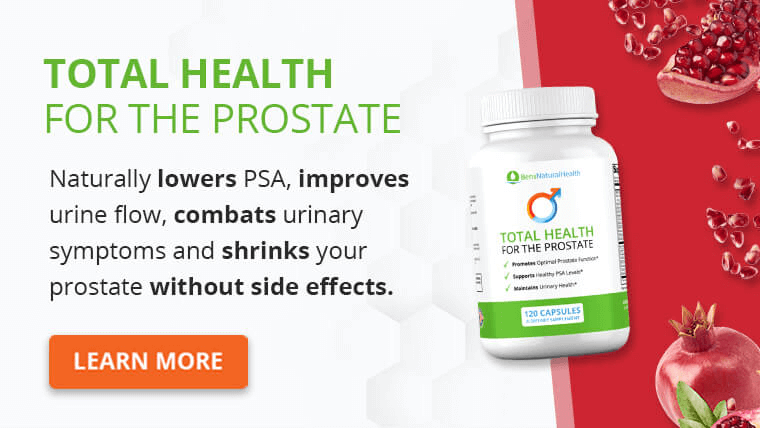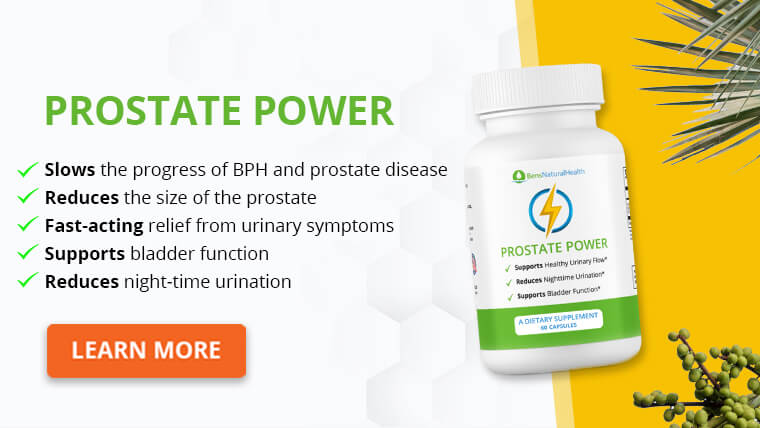As men age, the size of their prostate can become a growing concern. A normal prostate size is about 25 grams – roughly the size of a walnut.
However, conditions like benign prostatic hyperplasia can cause the prostate to grow over 3 times the normal size, reaching more than 80 grams.
The prostate size by age can vary from patient to patient.
The size of the prostate gland is one of the many factors doctors consider when figuring out if a man needs treatment for prostate enlargement.
Here, you can take a closer look at the size of the prostate, how it changes with age, and the symptoms of BPH.
Sign Up For Our Newsletter!
- Receive 10% off our best-selling supplements
- Get Your FREE PSA Lowering Diet Plan
- Be the first to hear about sales and promotions
- Stay up to date on our latest health news
What is a normal prostate size by age?
At birth, the prostate gland is roughly the size of a pea. The prostate keeps growing until you turn 20 when it weighs 15 grams to 20 grams. During the ages of 30 to 45, the prostate should remain stable at 20-25 grams.
For men older than 45, the prostate volume can grow unstable, and the size can gradually increase. In aging men, the prostate often increases in size.
Studies indicate that across a wide spectrum of ethnic and racial groups, prostate size increases from:
- 25 – 30 grams for men in their 40s
- 30 – 40 grams for men in their 50s
- 35 – 45 grams for men in their 60s
In the meantime, the transition zone of the prostate, which tends to be small at roughly 15 grams in men in their 40s, increases to around 25 grams for men in their 60s and 70s.
A medium prostate has a volume ranging from 40 ml to 80 ml. It can weigh 20 grams to 125 grams. A large prostate has a volume of 40 ml to 100 ml. It can weigh 40 grams to 125 grams.
The size of a normal prostate gland measures 3 × 3 × 5 cm roughly, or a volume of 25 ml. With BPH, the prostate gland can increase 4 to 5 times the initial size.

How does prostate size change as men age?
As men grow older, the average size of the prostate, which is the size of a walnut, can grow about the size of a lemon.
There is no clear reason as to why that happens. But, experts believe some male hormones, like dihydrotestosterone, have a major role to play.
The first time the prostate grows is during puberty. The second growth is at the age of 25 and keeps growing during most of a man’s life. As a man grows older, their prostate can grow bigger.
According to research, in men older than 60, the rate of increase in prostate length amplifies. This creates a bigger prostate diameter. But, before the age of 60, the prostate grows slowly. Whereas after 60, it drastically increases in length.
The bigger the prostate, the heavier the pressure on the urethra. This could cause a range of urination problems. Men might need to go to the bathroom more often, experience a change in the urine stream, or have trouble emptying their bladder.
Different diseases can affect the prostate. These include:
Benign prostatic hypertrophy (BPH)
BPH is when the prostate is big enough to cause problems. Different grades of prostate enlargement exist.
According to the American Urological Association, a score of 7 or less on the BPH symptom index means a mild BPH. A score of 8 to 19 means moderate BPH. And a score of 20 to 35 means severe BPH.
In some patients, the prostate enlarges massively. Eventually, weighing over 500 grams. This is known as giant prostatic hyperplasia (GPH).
Prostatitis
This prostate infection is inflammation of the prostate gland. The prostate becomes tender, inflamed, and swollen.
The presence of prostatitis is one of the risk factors for lower urinary tract symptoms (LUTS) with increased prostate volume.
Prostate cancer
This carcinoma forms in the prostate gland. It emerges when the cells in the prostate grow out of control.
In both prostate cancer and BPH patients, the prostate gland gets bigger. BPH is benign, while prostate cancer can spread to other regions of the body.
One of the most common prostate cancer risk factors is age. The older the patient, the bigger the odds of developing cancer. With an on-time prostate cancer diagnosis, patients can recognize the patterns and obtain the necessary treatment.
Ben’s Total Health For The Prostate
Ben’s Total Health for The Prostate is an all-natural, clinical-grade, prostate-relief supplement formulated to help shrink your prostate, lower your PSA levels, and relieve urinary symptoms.
It has a complete spectrum of 21 vitamins, 69 trace minerals, and natural herbs developed for the nutritional demands of men.
Clinical trials and meta-studies show that the active ingredients in Total Health for The Prostate have a positive impact on prostate volume, improve lower urinary tract symptoms, increase peak urinary flow, and decrease the risk of acute urinary retention.

Total Health contains 825mg of beta-sitosterol, the most effective and clinically proven natural Flomax substitute for men with prostate problems. Beta-sitosterol has been shown in studies to improve urinary symptoms and acts as a natural inhibitor of the 5 alpha-reductase enzyme to shrink the prostate.
Another important ingredient in Total Health is quercetin. One study found that quercetin supplementation results in significant symptomatic improvement for men with impaired prostate health.
Get 10% Off Our Products!
- Sign up to our newsletter
- Get Your FREE PSA Lowering Diet Plan
- Be the first to hear about sales and promotions
- Stay up to date on our latest health news
What is an enlarged prostate?
An enlarged prostate means that the gland has grown larger. Benign prostatic hyperplasia (BPH) refers to a non-malignant growth of prostate tissue.
It is a classic cause of LUTS symptoms in men. The prostate is found right beneath the bladder, and it surrounds parts of the urethra.
If the prostate becomes enlarged, it can push against the bladder muscles, urethra, and bladder. The constant pressure is weakening the bladder muscles.
To better understand enlarged prostate measurements, the prostate is typically considered enlarged on imaging when the prostate gland volume measures over 30 ccs (mL).
Age has a drastic impact on prostate volume. Reports of healthy Caucasian volunteers show a steady increase in mean prostate volume from 24 mL to 38 mL for those between the ages of 50-54 years and people older than 75 years.
Signs of an enlarged prostate
If the prostate is very enlarged, it can push against the urethra and bladder. This can trigger a wide range of symptoms. Such as:
- A strong and frequent urge to urinate, particularly at night
- Taking longer for the urine to start flowing
- Weaker urine stream
- Trouble emptying the bladder completely
BPH doesn’t impair ejaculation. But, some of the therapies for managing urinary symptoms could lead to ejaculatory dysfunction. Around 10% to 20% of BPH patients also have symptoms or a diagnosis of chronic pelvic pain syndrome. They tend to have urinary pain and discomfort.
In a small percentage of men, untreated prostate hyperplasia can cause urinary retention. The risk of urinary retention increases with age and as the symptoms get gradually worse.
Causes and risk factors
Prostate enlargement often develops in older men. Hormone changes can play a role. For instance, as men grow older, the levels of active testosterone plummet while the amount of estrogen remains the same.
The prostate size increases when these hormone changes cause prostate cell growth. Experts also suggest that the DHT (dihydrotestosterone) male hormone affects prostate development. Prostate enlargement occurs when an accumulation of androgens stimulates cell proliferation.
It prevents prostatic cell death, thus enhancing the size of the prostate gland. The BPH incidence increases with age. Many risk factors can contribute to the development of BPH. These are metabolic syndrome, hypertension, genetic predisposition, and obesity.
Men who are at risk of developing the condition are those:
- over the age of 50
- with a history of BPH
- obesity and overweight.

How to shrink an enlarged prostate naturally
Saw palmetto is one of the most popular herbal remedies for BPH treatment. Research demonstrates the effectiveness of saw palmetto in decreasing BPH symptoms.
This herbal remedy seems to have a similar effect to medications like finasteride. But, when comparing saw palmetto vs finasteride, saw palmetto is more affordable and better tolerated.
There are also no known drug interactions, and people experience minor and rare side effects. Saw palmetto has a wide range of uses. Many patients rely on this herbal product to treat chronic prostatitis.
Rye grass pollen extract (Cernilton) is another natural treatment alternative. Some people use this herbal supplement to improve urologic symptoms, including nocturia.
This product is commonly used by mouth for prostate conditions. Such as consistent swelling of the prostate, BPH, and prostate pain. It is one of the many phytotherapeutic agents available for treating prostatic hyperplasia.
How to prevent an enlarged prostate
Even though you can’t modify some factors for BPH, like genes and old age, there are a few things you can do to decrease the odds of developing this condition:
- Add some lifestyle changes, such as regular exercise and healthy food.
- Maintain healthy body weight.
- Manage the stress and relax more.
- Take supplements that can benefit the prostate, such as saw palmetto and ryegrass pollen.
To start eating healthy, it’s best to eat a low-fat diet with a variety of veggies and fruits. Do moderate to vigorous workouts and keep the body in tip-top shape.
Conclusion
Normal prostate size is the one that’s as big as a golf ball or walnut. When enlarged, the prostate can obstruct urine flow. As a result, men can experience frequent urination, feeling of urgency, slowness of the urinary stream, dribbling, etc.
Different conditions can affect the prostate. BPH and prostate cancer can increase prostate size, while prostatitis can cause inflammation or swelling.
Explore More








